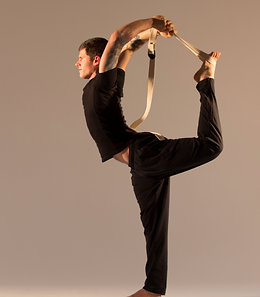
Triquetra Etkinlikleri

Triquetra Yoga Studio
What is Yoga?
Yoga is essentially a spiritual discipline based on an extremely subtle science, which focuses on bringing harmony between mind and body. It is an art and scince of healthy living. The word ‘Yoga’ is derived from the Sanskrit root ‘Yuj’, meaning ‘to join’ or ‘to yoke’ or ‘to unite’.
Yoga leads to the union of individual consciousness with that of the universal consciousness, indicating a perfect harmony between the mind and body, man and nature.
The aim of Yoga is self-realization, to overcome all kinds of sufferings leading to 'the state of liberation' (Moksha) or ‘freedom’ (Kaivalya). Living with freedom in all walks of life, health and harmony are the main objectives of Yoga practice. Yoga dates back to 2700 B.C. and has proven itself to catering to both the material and spiritual upliftment of humanity.
Yoga does not adhere to any particular religion, belief system or community; it has always been approached as a technology for inner wellbeing. Anyone who practices yoga with involvement can reap its benefits, irrespective of one’s faith, ethnicity or culture.
Traditional Schools of Yoga
-
Hatha Yoga (Yoga of Mind and Body Purification)
The syllable ‘ha’ denotes the sun or the pranic (vital) force governing the physical body and ‘tha’ denotes the moon or Chitta (mental) force thus making Hatha Yoga a catalyst to an awakening of the two energies that govern our lives. More correctly, the techniques described in Hatha Yoga harmonize and purify the body systems and focus the mind in preparation for more advanced chakra and Kundalini practices. The term Hatha Yoga has been commonly used to describe the practice of Asana (postures). However, the Hatha Yoga system includes not only Asanas but also the six Shatkarmas (physical and mental purification techniques), Mudras and Bandhas (psycho-physiological energy releasing techniques), and Pranayamas (pranic awakening practices).
-
Jnana Yoga (Yoga of Enquiry)
Jnana Yoga is the process of converting intellectual knowledge into practical wisdom. It is a discovery of human Dharma in relation to nature and the universe. Jnana Yoga is described by tradition as a means to obtain the highest meditative state and inner knowledge. Jnana literally means ‘knowledge’, but in the context of yoga, it means the process of meditative awareness, which leads to illuminative wisdom. It is not a method by which we try to find rational answers to eternal questions; but rather a part of meditation leading to self-inquiry and self-realization.
Some of the components of Jnana Yoga are:
-
Not believing but realizing
-
Self-awareness leading to self-analysis
-
Experiencing knowledge
-
Realizing one’s personal nature
-
Developing intuitive wisdom
-
Experiencing inner unity
-
Karma Yoga (Yoga of Action)
Karma Yoga is a path of devotion through work, or rather, service. One loses his identity while working, only selfless work remains. This state is very difficult to achieve. Non-attachment towards work and becoming the perfect instrument of the super consciousness in this manifested universe is the ultimate aim of Karma Yoga. In the initial stages of Karma Yoga, an individual possesses a strong sense of ego and consciously or unconsciously he is attached to the fruits of his efforts – he expects at least praise or recognition. However, being continually involved in work and developing a change in mental attitude, the individual can surely disassociate himself from the ego and his own personality. In this state the work becomes worship to God, it becomes spiritual where he achieves stability of mind in all conditions, he is not disturbed, excited, or happy in any situation. He becomes divine and his actions represent God’s will.
-
Bhakti Yoga (Yoga of Devotion)
Bhakti means Yoga of devotion or complete faith. This faith is generally in God or supreme consciousness in any form. It may be Lord Rama, Krishna, Christ, Mohammed, Buddha, etc. It may be a Guru for his disciples or love towards existence. The important thing is that a person interested in following this path must have a very strong emotional bond with the object of faith. The flow of emotional energy is directed to this object. Most people suppress their emotions, and that often manifests in the form of physical and mental disorders. Bhakti Yoga releases these suppressed emotions and brings about the purification of the inner self. Continuous meditation on God or an object of faith will gradually decrease the ego of the practitioner. This in turn prevents new distractions, fickleness, or even pain and induces strong bonds of love. Gradually, the practitioner loses self-identity and becomes one with the object of faith, this is a state of self-realization.
-
Mantra Yoga (Yoga of Recitation)
Mantras are Sanskrit syllables, words, or phrases, which when repeated in meditation, will bring an individual to a higher state of consciousness. Mantra Yoga has its origins in Vedic Sciences and also in the Tantras. In fact, all the verses in Vedas are called mantras, it is said that any person who can chant or sing Vedas can achieve ultimate salvation or union with supreme consciousness only by chanting the mantras, which is the aim of Mantra Yoga.
-
Kundalini Yoga (Yoga of Energy)
Kundalini Yoga is concerned with awakening the psychic centers or chakras, which exist in every individual. There are seven main chakras in the human body. The lowest level chakra connects us to the animal instinct level, while the highest level connects us to the instinctive realms of being or the sublime heights of consciousness. In Kundalini Yoga, higher-level chakras are awakened and in turn, the activities associated with these higher psychic centers are awakened as well. The basic method of awakening involves deep concentration on these chakras and forcing their arousal. Asanas, Pranayama, Mudra and Bandha and other forms of Yoga such as Mantra Yoga are also used to stimulate this awakening.
-
Iyengar Yoga
Iyengar’s method, a form of Hatha Yoga, is based on placing emphasis on the physical alignment of the body in the poses. In the Iyengar school, it is taught that there is a correct way to do each pose and that every student will one day be able to attain perfect poses through consistent practice. Once this balance is created in the body, it will be reflected in the mind. One of Iyengar’s major innovations is in the use of props. Today it is quite common to see blankets, blocks, straps, pillows, chairs, and bolsters being used in yoga studios. The use of these props is relatively new in the history of yoga and comes directly from Iyengar. The purpose of the usage of props is to assist the student in attaining ideal alignment, even if the body is not yet open enough.
-
Ashtanga Vinyasa Yoga
Ashtanga Yoga is an ancient system of Hatha Yoga, first recorded in the manuscript ‘Yoga Korunta’. For generations, Ashtanga Yoga has been passed down from one teacher to the next. In Ashtanga Yoga, there is one breath for each movement. The movements are meant to flow together so as to heal the body and produce a detoxifying sweat. This inner heat is also intended to burn away the six poisons (desire, anger, delusion, greed, envy, sloth) that surround the spiritual heart.
-
Raja Yoga (Yoga of Meditation)
Raja Yoga usually refers to the system of yoga as described in the Yoga Sutras of Patanjali. In this ancient text, Patanjali describes eight stages of yoga, which are known collectively as Raja Yoga or Ashtanga Yoga. Raja Yoga is a comprehensive yoga system that deals with the refinement of human behavior and personality through the practice of the Yamas (restraint) and Niyamas (disciplines); attainment of physical health and vitality through Asanas (postures) and Pranayamas (pranic breathing techniques); management of mental and emotional conflicts and development of awareness and concentration through Pratyahara (withdrawal of senses) and Dharana (concentration); and developing the creative aspect of consciousness for transcendental awareness through Dhyana (meditation) and Samadhi (absorption in the universal identity).
-
YAMAS – Restraints, moral disciplines or moral vows
This first limb, Yama, refers to vows, disciplines or practices that are primarily concerned with the world around us, and our interaction with it. While the practice of yoga can indeed increase physical strength and flexibility and aid in calming the mind, what’s the point if we’re still rigid, weak and stressed-out in day-to-day life?
There are five Yamas:
-
Ahimsa (non-violence),
-
Satya (truthfulness),
-
Asteya (non-stealing),
-
Brahmacharya (right use of energy), and
-
Aparigraha (non-greed or non-hoarding).
-
NIYAMAS – Positive duties or observances
The second limb of the 8 limbs of yoga, Niyama, usually refers to internal duties. The prefix ‘ni’ is a Sanskrit verb which means ‘inward’ or ‘within’.
There are five Niyamas:
-
saucha (cleanliness),
-
santosha (contentment),
-
tapas (discipline or burning desire or conversely, burning of desire),
-
svadhyaya (self-study or self-reflection, and study of spiritual texts), and
-
isvarapranidaha (surrender to a higher power).
-
ASANA – Posture
The physical aspect of yoga is the third step on the path to freedom, and if we’re being honest, the word asana here doesn’t refer to the ability to perform a handstand or an aesthetically impressive backbend, it means ‘seat’ – specifically the seat you would take for the practice of meditation. The only alignment instruction Patanjali gives for this asana is “sthira sukham asanam”, the posture should be steady and comfortable. The idea is to be able to sit in comfort so we’re not ‘pulled’ by aches and pains or restlessness due to being uncomfortable.
-
PRANAYAMA – Breathing Techniques
The word Prana refers to ‘energy’ or ‘life source’. It is often describe the very essence that keeps us alive, as well as the energy in the universe around us. Prana also often describes the breath, and by working with the way we breathe, we affect the mind in a very real way. We can interpret Pranayama in a couple of ways. ‘Prana-yama’ can mean ‘breath control’ or ‘breath restraint’, or ‘prana-ayama’ which would translate as ‘freedom of breath’, ‘breath expansion’ or ‘breath liberation’. Each way of breathing will change our state of being, but it’s up to us as to whether we perceive this as ‘controlling’ the way we feel or ‘freeing’ ourselves from the habitual way our mind may usually be.
-
PRATYAHARA – Sense withdrawal
Pratya means to ‘withdraw’, ‘draw in’ or ‘draw back’, and the second part ahara refers to anything we ‘take in’ by ourselves, such as the various sights, sounds andsmells our senses take in continuously. When sitting for a formal meditation practice, this is likely to be the first thing we do when we think we’re meditating; we focus on ‘drawing in’. The practice of drawing inward may include focussing on the way we’re breathing, so this limb would relate directly to the practice of pranayama too.
-
DHARANA – Focused Concentration
Dharana means ‘focused concentration’. Dha means ‘holding or maintaining’, and Ana means ‘other’ or ‘something else’. Closely linked to the previous two limbs; dharana and pratyahara are essential parts of the same aspect. In order to focus on something, we must withdraw our senses so that all attention is on that point of concentration. In order to draw our senses in, we must focus and concentrate intently.
-
DHYANA – Meditative Absorption
The seventh limb is ‘meditative absorption’ – when we become completely absorbed in the focus of our meditation, and this is when we’re really meditating. All the things we may learn in class are merely techniques in order to help us settle, focus and concentrate. The actual practice of meditation is definitely not something we can actively ‘do’, rather it describes the spontaneous action of something that happens as a result of everything else. Essentially; if you are really meditating, you won’t have the thought ‘oh, I’m meditating!’
-
SAMADHI – Bliss or Enlightenment
Many of us know the word samadhi as meaning ‘bliss’ or ‘enlightenment’, and this is the final step of the journey of Patanjali’s Yoga Sutras. After we’ve re-organised our relationships with the outside world and our own inner world, we come to the finale of bliss. Breaking the word in half, we see that this final stage is made up of two words; ‘sama’ meaning ‘same’ or ‘equal’, and ‘dhi’ meaning ‘to see’. There’s a reason it’s called realisation. It’s because reaching Samadhi is not about escapism, floating away or being abundantly joyful; it’s about realising the very life that lies in front of us. The ability to ‘see equally’ and without disturbance from the mind, without our experience being conditioned by likes, dislikes or habits, without a need to judge or become attached to any particular aspect; that is bliss.
Our Yoga Classes















